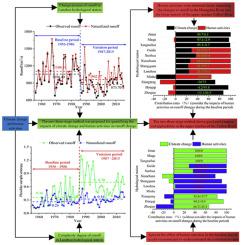Journal of Cleaner Production ( IF 9.7 ) Pub Date : 2020-11-24 , DOI: 10.1016/j.jclepro.2020.125017 Xianbao Su , Xungui Li , Zhenmin Niu , Nai’ang Wang , Xiaoyan Liang

|
The upper reaches of the Yellow River (URYR) comprise the main water-producing zone of the Yellow River Basin. Quantifying the contribution rates of climate change and human activities (CCHAs) to the changes in runoff in the URYR is critical for formulating rational water resource management strategies in the entire basin. The main objective of this study is to combine the advantages of flexible sample entropy and multiscale entropy to propose a new three-stage method (TSM) to quantify the contribution rates of CCHAs to changes in runoff in the URYR above the city of Lanzhou during 1956–2015. The results show that climate change is the dominant factor affecting the changes in runoff in the study area over the period of study. However, compared with the baseline period (BP; 1956–1986), the variation period (VP; 1987–2015) experienced notably different impacts of CCHAs on the runoff changes. Human activities constituted the dominant factor impacting the changes in runoff in the Huangshui River and the lower section of the URYR (average contribution rate of 70.9%). Meanwhile, climate change was the dominant factor affecting changes in runoff in other regions of the URYR (average contribution rate of 91.8%). Declining precipitation, increasing temperature and evaporation, changing watershed surfaces, the construction of reservoirs and water diversion projects, and increasing human water consumption have resulted in varying degrees of runoff complexity. The novelty and uniqueness of this study can be ascribed to the TSM that (1) considers the impacts of human activities on changes in runoff during the BP and combines the advantages of single time-scale and multiscale entropy for the first time; and (2) uses positive and negative contribution rates to represent the increase and decrease in runoff complexity, respectively. The method exhibits appreciable performance and applicability in the URYR and other watersheds to effectively calculate the contribution rates of the CCHAs to changes in runoff.
中文翻译:

一种新的基于复杂度的三阶段方法,可对黄河上游气候变化和人类活动对径流变化的正负贡献率进行定量
黄河上游(URYR)构成了黄河流域的主要产水区。量化气候变化和人类活动(UR)对URYR径流变化的贡献率对于制定整个流域的合理水资源管理策略至关重要。这项研究的主要目的是结合灵活的样本熵和多尺度熵的优点,提出一种新的三阶段方法(TSM),以量化CCHAs对1956年兰州市上空URYR径流变化的贡献率。 –2015年。结果表明,在研究期内,气候变化是影响研究区径流变化的主要因素。但是,与基线期(BP; 1956–1986)相比,变异期(VP; 1987-2015年),CCHAs对径流变化的影响明显不同。人为活动是影响s水河和乌拉圭乌拉圭回灌河下游径流量变化的主要因素(平均贡献率为70.9%)。同时,气候变化是影响URYR其他地区径流变化的主要因素(平均贡献率为91.8%)。降雨的减少,温度和蒸发量的增加,流域表面的变化,水库的建设和引水工程的发展以及人类耗水量的增加导致径流复杂性的程度不同。这项研究的新颖性和独特性可以归因于TSM:(1)首次考虑了人类活动对BP期间径流变化的影响,并首次结合了单一时间尺度和多尺度熵的优点;(2)使用正和负贡献率分别代表径流复杂性的增加和减少。该方法在URYR和其他流域中表现出明显的性能和适用性,可以有效地计算出CCHA对径流变化的贡献率。











































 京公网安备 11010802027423号
京公网安备 11010802027423号